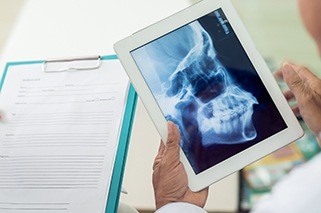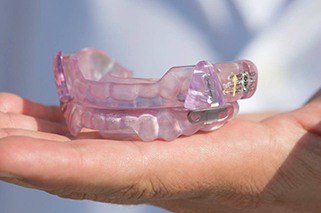


“TMJ,” or temporomandibular joint, is the official name for the joint that allows your lower jaw to move fluidly whenever you eat, speak, laugh, or yawn, and like other joints in the body, it can sometimes become strained or injured. This can lead to something called a TMJ disorder, or TMD, which can cause symptoms such as a stiff and painful jaw, persistent headaches, earaches, and even neck and shoulder pain. Fortunately, Dr. Petty is able to diagnose and treat these kinds of issues here in our Tullahoma office, so if any of these symptoms sound familiar, contact us today to get the relief you need.

A TMD can be caused by various factors, but the most common tend to be:
Determining the cause of your TMD will help Dr. Petty figure out which treatment is right for you. To do this, he will ask you about your symptoms, examine your teeth, test the mobility of your jaw, as well as use X-rays to see the condition of the joint.
From there, he will work with you to put together a treatment plan that will relieve your symptoms. For some, the answer is as easy as reducing daily stress or performing helpful facial stretches during the day. For others, he may need to utilize more hands-on treatments, which you can learn more about below. Thankfully, these treatments are relatively non-invasive and have been shown to have a very high rate of success.

A slight misalignment of the bite can cause the jaw to make small adjustments whenever it opens and closes, and this can lead to quite a bit of wear and tear on the joint as well as muscle tension that can cause pain. The best way to fix this is by directly addressing the misalignment, which Dr. Petty can do with an equilibration/occlusal adjustment. He’ll gently reshape a few key teeth so your bite comes together properly, which should help the jaw reach its natural resting position, relieving any pain and tension.

An occlusal splint is a type of mouthpiece that can be used to address and relieve various TMD-related symptoms. Each one is custom-made for every patient, and it only needs to be worn to bed. It works by slightly shifting the jaw forward into a more relaxed and healthy orientation. It also helps by providing a barrier between the teeth to prevent unconscious grinding (which is very common for people with TMD). Over time, pain should lessen, and other symptoms should slowly start to disappear as well.

Dr. Petty and our team are ready to help you find long-lasting relief from the persistent jaw pain and other symptoms that characterize TMD. Before you contact us to schedule your consultation, though, it is understandable if you want to learn more about TMD and your TMJ in Tullahoma. Below, you will find answers to some frequently asked questions. If your specific questions aren’t addressed here, feel free to give our office a call — we are always happy to share our knowledge!
Some patients have found mild relief by employing home remedies for their TMD. For example, jaw exercises and stretches may help to strengthen the muscles around the joint and reduce unpleasant symptoms. Other things that might help include:
Anyone can develop TMD. However, it is most common in women of childbearing age. There are different theories as to why this is the case. Some researchers believe it is due to hormonal differences between the sexes as well as differences in how the sexes respond to emotional stimuli. There are also some minor variations between male and female jaw anatomy, which may contribute to the higher prevalence of TMD in women.
The best thing you can do to reduce your risk of TMD is to avoid or limit activities that can strain or injure your TMJ. For example, you should maintain proper posture, do your best not to grind your teeth, and enjoy chewing gum in moderation. Additionally, bear in mind that dental misalignment is often a contributing factor to TMD. If you have crooked teeth, braces or clear aligners may lower your risk of future problems with your TMJ.
Surgery is a last resort when it comes to addressing TMD. Before recommending it for you, Dr. Petty will explore all less invasive treatment options. If it looks like surgery would be the best option for you, you may be referred to a local oral and maxillofacial surgeon who has extensive training and experience in performing procedures on the jaw and TMJ.
Some patients find that their symptoms disappear on their own, even without professional treatment or the use of at-home remedies. However, the underlying issue that caused the TMD may still be present. That is why it is always best to consult with a qualified dentist if you are experiencing jaw pain or any other problems that indicate an issue with your TMJ.